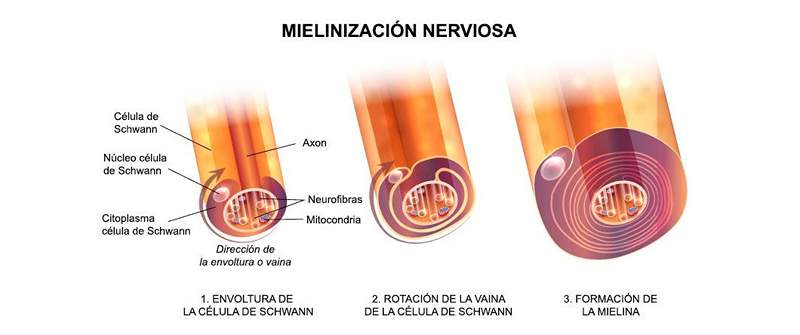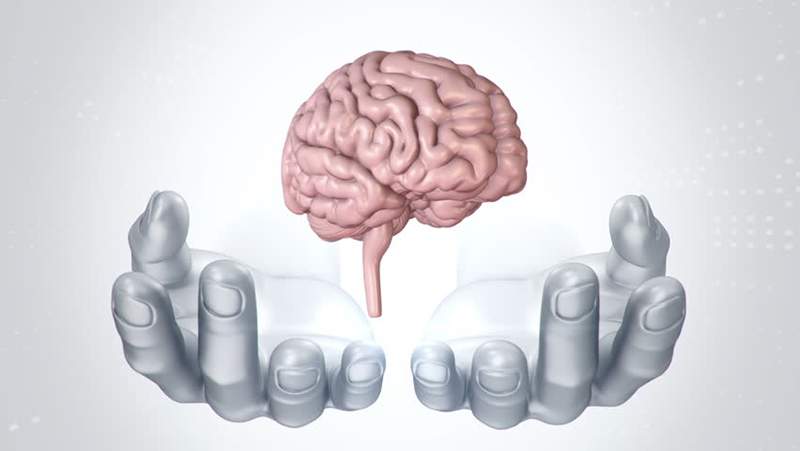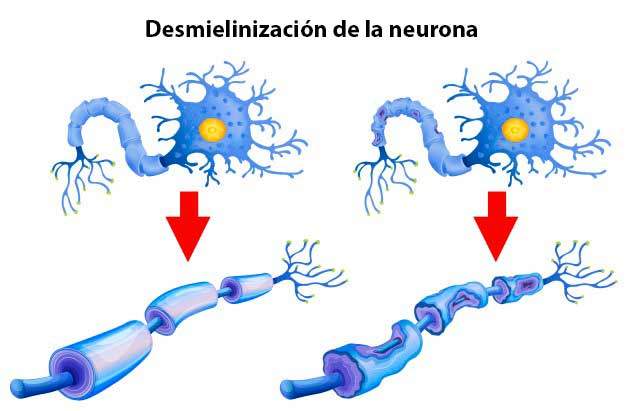Myelin, what is and what is its function

- 1444
- 417
- Gregory King
Myelin is a white fat substance that surrounds the axon of some nerve cells, forming an insulating layer. It is essential for the proper functioning of the nervous system. It is a part of a type of glial cell.
Content
Toggle- What is myelin
- What is myelinization
- Myelin function
- Myelin or demyelinization disorders
- Schizophrenia, bipolar and myelin disorder
- Symptoms of demyelinization
- The symptoms can be:
- Myelin repair
- References
What is myelin
Neurons are the cells of the nervous system and thanks to them we are able to think, see, hear, talk, feel, move .. Each neuron consists of a cell body and an axon (The extension of the cell body that transports the messages). Most axons in the central nervous system are wrapped in myelin, a substance rich in lipids (fatty substances) and proteins. Like the coating of an electric cable, Myelin isolates and protects axon and helps accelerate nerve transmission.
Myelin is present in the central nervous system (CNS) and the peripheral nervous system (SNP). CNS myelin is produced by special cells called oligodendrocytes. SNP myelin is produced by Schwann cells. The two types of myelin are chemically different, but both perform the same function: promote the efficient transmission of a nerve impulse throughout the axon.
What is myelinization
Myelin sheath production is called myelinization or myelinogenesis. In humans, myelinization begins early, during the third trimester of pregnancy, although there is little myelin in the brain at the time of birth. During childhood, myelination occurs rapidly, which in turn leads to the rapid development of the child, which includes crawling and walking during the first year. Myelinization continues during the adolescent stage of life.
 The Hand Syndrome (SMA)
The Hand Syndrome (SMA) Myelin function
The main objective of a myelin sheath is increase the speed at which impulses spread along myelin fiber. Throughout the amielinic fibers, impulses move continuously as waves, but in myelinized fibers, they "jump" or spread by saltory driving. Myelin decreases capacitance and increases electrical resistance through cell membrane (axolema). Therefore, myelination prevents electric current from coming out of axon. It is believed that myelin allows a larger body size by maintaining agile communication between the distant parts of the body.
Schwann cells supply myelin for the peripheral nervous system, while the oligodendrocytes, specifically of the interphicular type, Mielinize the axons of the central nervous system. Myelin is considered a defining characteristic of vertebrates, but myelin -like pods have also been observed in some invertebrates, although they are quite different from vertebrate myelin at the molecular level.
The most important function of myelin sheath is therefore Accelerate depolarization throughout the axon, avoiding sodium filtration, maintaining a strong load difference between inside and outside the axon. In a way, it helps the signals move quickly directly. Because neurons are so tight (especially in the brain, where space is limited, but needs to process so much information), they are always in contact with each other.
What would happen if the axons without the rubber wrap? Well, our body would be a chaotic disaster. Thanks to the fat cover that isolates electricity, we send the correct impulses to the right place, quickly and efficiently. In addition, our neurons are not damaged by the constant flow of electrical impulses due to this cover, such as rubber wire, which does not burn as easily as the one that does not have.
Myelin or demyelinization disorders
Demonicization is the loss of myelin wrapping that isolates the nerves And it is what characterizes some neurodegenerative autoimmune diseases, such as multiple sclerosis, acute disseminated encephalyitis, optical neuromyelitis, transverse myelitis, the chronic inflammatory demyelinating polyneuropathy, Canavan disease, Guillain-Barré syndrome, central myelinosis pontine honeyinosis E Even schizophrenia and bipolar disorder. There are also congenital demyelinizing diseases such as leukodystrophic and pondo-marie-tooth disease.
Patients with pernicious anemia may also suffer serious neuronal damage. Degeneration of the spinal cord secondary to pernicious anemia can cause damage to the peripheral nerves of the central nervous system, affecting speech, balance and cognitive consciousness. When myelin degrades, the conduction of the signals along the nerve can be affected or lost, and the nerve eventually withers.
Schizophrenia, bipolar and myelin disorder
Have been found Anomalies in neuronal axons and myelin in patients with schizophrenia and bipolar disorder, compared to healthy individuals. More specifically, there was a reduction in myelin in white matter neurons, as well as an abnormal diffusion of N - Acetyl aspartate, a metabolite that is within nerve cells.
Apparently, both bipolar disorder and schizophrenia have common causes, even if they are two different diseases. The reduction in myelin production is the most likely cause of the genesis of both diseases, only that anomalies take different paths. It is believed that this deficit is causing by oligodendrocytes, that produce less myelin than necessary by not receiving enough energy. But the causes of this disorder are yet to be clarified.
 50 phrases from Santiago Ramón y Cajal
50 phrases from Santiago Ramón y Cajal Symptoms of demyelinization
Demonicization produces various symptoms depending on the functions of the affected neurons. The signals between the brain and other parts of the body are interrupted, so the symptoms differ depending on the affected areas.

The symptoms can be:
- Loss of vision / hearing
- Double vision
- Blurred vision in the central visual field that affects a single eye, can be accompanied by pain to the movement of the eye
- Strange sensation in legs, arms, chest or face, such as tingling or numbness (neuropathy)
- Weakness in arms or legs
- Speech deterioration and memory loss
- Heat sensitivity (symptoms worsen or reappear when exposed to heat, like a hot shower)
- Difficulty in coordinating movement or balance
- Difficulty controlling intestinal evacuations or urination
- Fatigue
- Tinnitus or aquefenos (internal sounds in the ear)
Myelin repair
Research on the possible repair of damaged myelin sheaths is in process. Some techniques include surgically implant. While the results in mice have been encouraging (through stem cell transplantation), it is still unknown if this technique can be effective in replacing myelin loss in humans.
On the other hand, cholinergic treatments, such as acetylcholinesterase inhibitors (ACHEI), can have beneficial effects on myelinization, repairing it. The increase in cholinergic stimulation can also act through subtle trophic effects on brain development processes and, in particular, in oligodendrocytes and myelinization process. By increasing cholinergic stimulation of oligodendrocytes, achei and other cholinergic treatments could possibly promote myelinization during the development and repair of myelin in old age.
References
https: // academic.OUP.com/schizophreniabulotin/article/43/3/473/3062417
https: // www.Nationalmsociety.Org/What-Is-MS/Definition-OF-MS/MYELIN
https: // www.NCBI.NLM.NIH.GOV/Books/NBK27954/
http: // www.Union.Org/News/Psychosis.HTML

